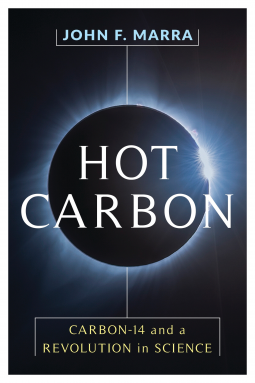
Hot Carbon
Carbon-14 and a Revolution in Science
by John F. Marra
This title was previously available on NetGalley and is now archived.
Send NetGalley books directly to your Kindle or Kindle app
1
To read on a Kindle or Kindle app, please add kindle@netgalley.com as an approved email address to receive files in your Amazon account. Click here for step-by-step instructions.
2
Also find your Kindle email address within your Amazon account, and enter it here.
Pub Date Jun 25 2019 | Archive Date Sep 24 2019
Talking about this book? Use #HotCarbon #NetGalley. More hashtag tips!
Description
There are few fields of science that carbon-14 has not touched. A radioactive isotope of carbon, it stands out for its unusually long half-life. Best known for its application to estimating the age of artifacts—carbon dating—carbon-14 helped reveal new chronologies of human civilization and geological time. Everything containing carbon, the basis of all life, could be placed in time according to the clock of radioactive decay, with research applications ranging from archeology to oceanography to climatology. In Hot Carbon, John F. Marra tells the untold story of this scientific revolution. He weaves together the workings of the many disciplines that employ carbon-14 with gripping tales of the individuals who pioneered its possibilities. He describes the concrete applications of carbon-14 to the study of all the stuff of life on earth, from climate science’s understanding of change over time to his own work on oceanic photosynthesis with microscopic phytoplankton. Marra’s engaging narrative encompasses nuclear testing, the peopling of the Americas, elephant poaching, and the flax plants used for the linen in the Shroud of Turin. Combining colorful narrative prose with accessible explanations of fundamental science, Hot Carbon is a thought-provoking exploration of how the power of carbon-14 informs our relationship to the past.
John F. Marra is professor of earth and environmental science and director of the Aquatic Research and Environmental Assessment Center at Brooklyn College. He was previously a research scientist and associate director of the Division of Biology and Paleoenvironment at Columbia University’s Lamont-Doherty Earth Observatory.
Advance Praise
"This is an engaging and witty account of the discovery of carbon-14 – there are surprising twists and turns along the way. With its entertaining descriptions of carbon-14’s role in understanding fundamental life processes, dating archaeological specimens, and chronicling past climate, this book is a page-turner for anyone interested in the history of scientific discovery."
-James J. McCarthy, Alexander Agassiz Professor of Biological Oceanography, Harvard University
Available Editions
| EDITION | Other Format |
| ISBN | 9780231186704 |
| PRICE | $35.00 (USD) |
Average rating from 10 members
Featured Reviews
 Paul V, Reviewer
Paul V, Reviewer
If you like science even a little, and/or get excited about discussions of things like atoms and electromagnetic spectrums, you'll love this. But you don't have to have a science background to enjoy it. The author does a great job of providing history and context (plus photos and diagrams) to provide an interesting history to the amazing carbon-14 and its discovery.
Thanks very much for the ARC for review!
 Claudia D, Reviewer
Claudia D, Reviewer
Hot Carbon sounded to be another hit for me. Unfortunately, it wasn’t.
The facts presented are very interesting; I didn’t know much about Carbon 14 other than its use for age dating so I learned quite a few new things. However, all those presented are before the ‘90s. For a book written/published in 2019, especially a scientific one, that’s a big minus, in my opinion.
The history of its discovery, the way it’s found in nature and its applications are quite engaging. For all that, the way the story was told is another matter. There are too many details not related to it, not so interesting from my PoV, and too few experiments. And those which are presented are so stretched out that you forget what the experiment was about in the first place.
The writing is tedious, I didn’t find it gripping at all. It’s also very repetitive; the same info is repeated over and over again. If it was explained once, I don’t want to be reminded of it every few other pages and with references when it was mentioned before.
If you expect a riveting popularizing science book, this is not the best choice. Nonetheless, if the subject is of high interest, you might find it more compelling than me. It was not one of the best science books out there, but definitely not a waste of time.
 Sam S, Reviewer
Sam S, Reviewer
Written by John F. Marra, Hot Carbon is a non-fiction novel that looks at how carbon, and carbon-14 in particular, has shaped what is our modern world and how research has developed in the field, and the variety of fields that carbon-14 effects.
With some personal anecdotes (including the opening scene), Marra paints for us how influential carbon-14 is and how little we realize the large effect it has. I have a background in chemical engineering – emphasis on the chemical – but in the field that I work in, we deal a lot with carbon, but not carbon-14.
In research, however, carbon-14 is so influential. It is a way to, more often indirectly, measure a variety of things. From dating to the energy production of plants. It is amazing.
And yes, that is all the detail I will go into, because this is a book worth reading. It reads easily and well – more so after the initial little story – and does a fantastic job of bringing this important isotope into the real of discussion for those who don’t have a background in chemistry.
I did receive a copy from Netgalley in exchange for an honest review.
 Roxanne S, Reviewer
Roxanne S, Reviewer
This was an easy-to-understand description of the discovery of radioactivity in general and the utility of carbon-14 in particular. In the digital ARC I received from NetGalley, there was an error in the definition of isotope which prevents me from giving this a higher recommendation. Contrary to the text in Hot Carbon, all isotopes of an element must have the same number of protons, though they do have different numbers of neutrons.
 Reviewer 230681
Reviewer 230681
I read an uncorrected proof of John F. Marra’s Hot Carbon; Carbon-14 and a Revolution in Science, (protected PDF on kindle), provided to me by Columbia University Press through netgalley, as an advance reader copy in return for promising to write an honest review. The book is scheduled for release on June 25, 2019. Marra is a professor of Earth and Environmental Sciences at Brooklyn College of City University of New York. Prior to that he was a research scientist at Lamont-Doherty Earth Observatory of Columbia University from 1977-2007. His research concentrations are in ocean photosynthesis and marine phytoplankton.
The book takes a historical approach to the discovery and use of carbon-14 in a cross-disciplinary fashion, that drives towards its applications in oceanography. That is, working backwards, what physics, chemistry, biology, earth science, and instrumentation technology does the reader need to know before they can understand the oceanographic issues? Now, as an engineer of applications of biomedical physics, I was personally unaware of those applications, and so it was an important learning for me. At the same time, the needed foundational work overlapped with my area of interest, and was well presented. The anecdotal stories of the critical scientists’ lives really captured my imagination. I think I would enjoy Professor Marra’s style in coursework.
However, I was very disturbed about a misstatement regarding isotopes that occurs twice in the early chapters. He claims that N-14 gives up a neutron to change it to C-14. But that would change it to N-13, not C-14! In fact, N-14 swaps out a proton to pick up a neutron in order to produce C-14. Clearly, when he gives subsequent explanations, Marra does understand this. It is just unfortunate that no technical editing caught this fundamental and credibility-damaging error.
The text makes good use of illustrations and figures to explain how the data works. This writing is not a glossing over with sweeping conclusions about what “science says,” like so many. Marra explains the reasoning, and teaches the scientific background necessary to make the judgements. The math does not go beyond logarithms and what I consider high-school level, but it is used. That background is deep, but not broad. For example, there is a lot more to organic chemistry than photosynthesis, but for starting points, it is a good one, that relates to everyday life.
The oceanography is pretty technical and somewhat arcane, as Marra moves into his particular expertise. Even so, it does relate to current issues in climate science. A lot of climate science is of a first-time speculative nature. Unfortunately, by the time the impact of increased CO2, methane, and other greenhouse gasses are as confirmed as the materials of the earlier chapters, it may be too late to avoid consequences disastrous to human life. The record of past climate change has shown a susceptibility to rapid change, especially in continental areas influenced by the global pattern of ocean currents.
I recommend this book to scientifically-oriented readers, who wish to broaden their perspective. Hopefully, by the time of a second edition, I can move that to “highly recommend”.
 Michele B, Reviewer
Michele B, Reviewer
This book was very interesting. I had always wondered how carbon 14 helped scientists date relics. The author goes through the details behind that, bringing up unique carbon-14 signatures associated with development and testing of the atomic bomb and changes in ocean currents. It is amazing how so much of the natural world ties to this topic. Some of the detailed discussion in the middle to later chapters was beyond me, but the author always brought it back around to the main conclusions, so I could skip those parts and still learn an awful lot. I really appreciate the insight I got from this book. Recommended reading!
I got a copy of this book for free to read and review. All opinions above are my own.
Who would enjoy this book?
This volume would appeal most to those with a scientific focus. Students of the Environmental Sciences would be the best candidates to enjoy the offering in Hot Carbon. I studied a different scientific profession, and yet, I still found this first outing by Marra to be entertaining and enlightening, although replete with factual errors. If you have an interest in learning new things, this book will be an exciting read. Almost, anyone over 16 years old will find this a useful addition to their bookshelf.
About the Author
John F. Marra is a veteran of the U.S. Navy, and after a non-traditional route became involved in oceanographic based research. He has been studying the oceans and the effects of carbon 14 for over 30 years.
Even though he was a Chicago boy, he had a strong desire to sail the seas, eventually becoming a Naval Officer. The sea wasn’t his only calling however, and being the possessor of a sharp mind, he developed a keen interest in nature and the natural world in general. Marra eventually resigned his commission to study in a graduate program as a research assistant. His CV is resplendent with many long years of oceanographic research. He moved to a more academic track and has enjoyed success in his field. He is currently a Professor and Director of AREAC Earth and Environmental Sciences at Brooklyn College.
Find out more about John Marra here: http://www.brooklyn.cuny.edu/web/academics/faculty/faculty_profile.jsp?faculty=662
What is the story about?
The bulk of the book revolves around Carbon 14 and its universal ubiquity. Marra explains, in lucid and concise terms, the importance of the isotope and its unique importance to life on earth as it corresponds to the process of photosynthesis and its interaction with microscopic phytoplankton. The book is beautifully illustrated with a plethora of images, maps, charts, and tables.
From the inception, I found the book particularly delightful and entertaining; two responses I don’t usually get from what I thought was a hardcore science thesis. In the first few pages you are left in no doubt of Marra’s dedication to his work as he describes the privations on one of his many research trips. He effectively depicts the myriad of dangers and the deadly nature of the job. For a brief moment, I believed that I was reading an adventure book, rather than what could have been a stultifying stuffy re-telling of some mediocre scientific research. I was hooked on the book and couldn’t wait to finish.
I was particularly struck by the understated delivery of the prose. His descriptions, explanations, and familiarity with the subject really sold the story and highlighted his abilities as a professor. It was an easier read than expected and that added to its allure. I was disappointed when the book ended; it left me wanting more. I understand that this is Marra’s first book and I hope it won’t be his last. I will certainly be pre-ordering his next publication. So please John, don’t keep us waiting.
In Conclusion
There are areas where those who didn’t pay attention in organic chemistry may get a little lost in the translation of detailed processes, but it’s not a deal breaker in any way.
Overall, I found this volume to be a pleasure to read, easily accessible, and well written. You don’t have to be a scientist to enjoy this book. Put simply, you don’t want to be the one person in class not to have read this; don’t be that guy!
Acknowledgements
I wish to extend my kindest regards to The Author, The Publisher, and NetGalley for giving me the opportunity to review this wonderful book.













